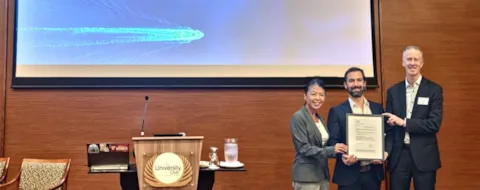DNV awards SeaTech Solutions AiP for new ammonia bunkering vessel design
As part of the Ammonia Energy APAC Conference 2025, Classification society DNV has awarded an Approval in Principle (AiP) to SeaTech Solutions International (SeaTech) in collaboration with Oceania Marine Energy (Oceania) for the design of a new 10,000cbm ammonia bunkering vessel. This AiP builds on a recent Memorandum of Understanding (MoU) between DNV, SeaTech, and Oceania, initiated at Singapore Maritime Week and signed in April this year.
Located in the Pilbara region, home to the world’s largest bulk export port, the Port of Dampier is emerging as a potential hub for low-carbon ammonia bunkering. Driven by a rising demand for low- and zero-carbon shipping fuels from the region’s mining and export industries, the port has built considerable experience in dealing with ammonia cargoes and vessels and is developing a strategy to facilitate ammonia bunkering operations. This includes the successful completion of its first ship-to-ship pilot bunkering transfer in September 2024.
Measuring 130-metres, the ammonia bunkering vessel is specifically designed to deliver low-carbon ammonia to ammonia dual-fuelled bulk carriers at the Port of Dampier. It can supply up to 9,000cbm of fuel, sufficient to support two round-trips of iron ore shipment between Australia and North Asia. The vessel’s optimized arrangement and advanced containment systems enable efficient ship-to-ship transfers while ensuring the safe handling of ammonia as both a cargo and marine fuel.
Nick Bentley, Managing Director at Oceania Marine Energy, said: “Oceania is proud to have worked in tandem with DNV and SeaTech to deliver a flagship, low-emissions marine fuel solution at the heart of Australia’s heaviest resource export hub. The completion of this MOU and Approval in Principle (AiP) award by DNV for our 10,000m³ clean ammonia bunker vessel marks a major milestone in developing the supply and bunker operation foundations for the low-carbon shipping Pilbara–Asia green-corridor. This initiative reinforces Oceania’s commitment to deliver 1 million tonnes of clean marine fuel by 2030 and positions Dampier in Western Australia as a future leader, enabling the shipping industry’s transition to near net-zero marine fuel.”
Prabjot Singh Chopra, Vice President of Technology at SeaTech Solutions said: “We are proud to work alongside Oceania and DNV to bring this innovative ammonia bunkering vessel design to life. As part of the maritime industry's multi-fuel transition to low- and zero-carbon energy, ammonia stands out as a viable option for long-haul shipping—and enabling its safe and efficient delivery is critical. Our vessel design incorporates a high level of automation and smart control systems to ensure safe handling of ammonia, enhancing both crew safety and operational reliability during ship-to-ship transfers. This Approval in Principle marks a key milestone, not just for the vessel, but for the broader ecosystem that must be in place to support ammonia bunkering. With Dampier emerging as a green marine fuel hub, and with SeaTech (Australia) actively engaged in supporting decarbonisation initiatives aligned with Australia’s net zero ambitions, we bring a strong track record and deep expertise to deliver practical, scalable solutions that enable the decarbonisation of global shipping.”
Antony M Dsouza, Senior Vice President & Regional Manager, South East Asia, Pacific & India, Maritime at DNV, added: “Scaling up production and bunkering infrastructure remains one of the biggest challenges in the maritime energy transition, and will be vital to the adoption of alternative fuels at scale. This AiP is another step in realizing operationally ready bunkering capabilities and strengthening industry confidence in the potential of ammonia as a carbon-free fuel for shipping. At DNV, we’re proud to support forward-thinking partners like SeaTech and Oceania with the trusted technical assurance and deep expertise needed to realize the industry’s decarbonization ambitions.”
Although ammonia is a viable alternative fuel, its toxic and corrosive nature demands stringent handling and safety protocols. Mitigating operational risks requires not only comprehensive crew training but also robust technical safeguards and systems. DNV’s latest white paper, Safe Introduction of Alternative Fuels – Focuses on Ammonia and Hydrogen as Ship Fuels, outlines seven steps to assist shipowners and other stakeholders in obtaining approval and deploying ammonia- ships, including the safety challenges, operating procedures, training, and organizational changes needed in today’s complex regulatory environment.
DNV has a long history of working on initiatives to support the development and uptake of ammonia as a marine fuel, including a recent ammonia bunkering safety study for the Global Centre for Maritime Decarbonisation (GCMD), which was utilized in the ship-to-ship ammonia transfer pilot at the Port of Dampier.
An Approval in Principle (AiP) is an independent assessment of a concept within an agreed framework, confirming that the design is feasible, and no significant obstacles exist to prevent the concept from being realized.

